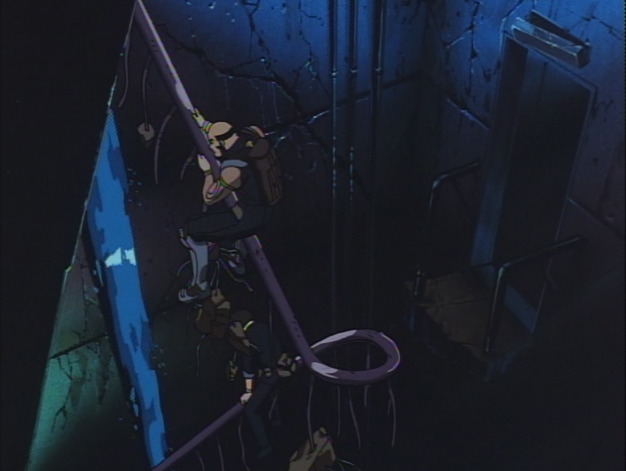
Not part of a hallucination, believe it or not.
18) Speak Like a Child
This is the episode where the “Coming Next Week!” crawl ends with a sheepish admission that the story is kind of pointless. But if you’ve been watching the show along with me, you’ve probably gotten in the habit of never trusting a flippin’ THING that the writers tell you. So if they say that this one is not important, it must be super, super important, right? Right! Nothing much happens on the surface, true, but this episode has unplumbed depths. (HA!) Don’t get the joke? Well I’ll explain.
So, there’s a term that pops up in literary criticism, “mise-en-abyme,” that has a few interrelated meanings. It refers to placing something between two mirrors, so that it is reflected infinitely. From this (possibly), it also refers to images or stories that contain smaller copies of themselves (you know, like “It was a dark and stormy night. The Captain stood upon the deck and said, “Tell me a story, my son!” So I began: “It was a dark and stormy night. The Captain stood upon the deck and said, “Tell me a story, my son!” So I began: “It was a dark and stormy night… etc.” etc.” etc.” etc.”). And from this (again, possibly), it also takes on the more general sense of any story-within-a-story construction, and any aspect of a fictional work which draws our attention to the fact that the work is fictional.
My read on “Speak Like a Child” is that the writing staff decided to make an episode which is mise-en-abymed out the freaking wazoo. By which I mean that this episode plays with mise-en-abyme the way that the last episode plays with Blaxploitation. Although in this case, the background texture and the episode’s real point are not completely unrelated… but maybe I’d better get around to explaining the plot.
The episode kicks off with Jet telling Ed the story of Urashima Taro, a Japanese Rip Van Winkle analogue who traveled to the Dragon King’s palace on the bottom of the ocean, spent one night, and returned to land only to find that 60 years had passed. So right off the bat, note the resemblance to Faye, who spent almost 60 years in cryogenic storage (mise-en-abyme count=1). This is interrupted by the delivery of a mysterious package addressed to Faye, which – we later learn – has been bouncing around the solar system since before she went into cold sleep. Note that it’s delivered by the Turtle shipping company – another connection of Faye’s past to a nautical symbol, and a direct connection to the Urashima Taro story, which features a turtle heavily. The connection of the (ostensibly real) main narrative to the (obviously fictional) fairy tale draws our attention to the fact that the main narrative is fictional. Mise-en-abyme count = 2.
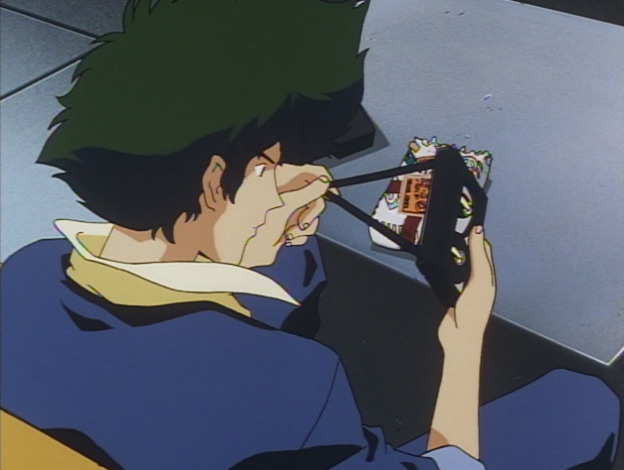
Now, Faye doesn’t know what’s in the package, so she assumes that it’s from a collection agency, and runs off without opening it. Spike, being a curious sort (although… since when?) opens it anyway, revealing a videocassette, i.e. still the dominant TV recording medium at the time when Cowboy Bebop was being aired. (Mise-en-abyme count – henceforth MEAC, because boy howdy we are going to be see a lot of that phrase – equals 3). No wait! Urashima Taro famously came up out of the ocean with a magic box that he was told never to open, and when he did open it – they always do, in these stories – it turned out to contain all of his lost years. And here we’ve got this cassette, which is kind of box shaped, and they can’t get at the information inside it, and it contains the secret of Faye’s lost past. So the MEAC is at four already. At least.
(Incidentally, just to get this out of the way: Faye spends the rest of the episode gambling on horse and grayhound races, before finally deciding that she misses her friends, and coming back to the BeBop. The fact that she makes this decision is a crucial, crucial moment for her character arc, even if she doesn’t quite admit it to herself yet. And while we’re on the subject of character development, the fact that Jet is telling Ed a fairy tale is also kind of significant, because it marks his transition from someone who is serving in loco parentis by keeping Ed fed and clothed, to someone who is actually trying to be a father. But both of these important psychological developments are more or less glossed over in the show itself, so I’ll give them similarly short shrift here.)
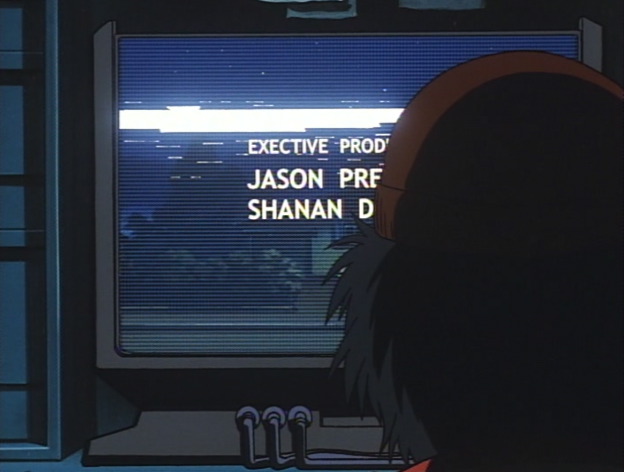
Anyway, Jet and Spike decide that they want to know what’s on the tape, so they track down a vintage electronics collector. And yes, when they come into his shop, he’s watching an episode of Beverly Hills 90210. He helpfully informs them that what they’ve got there is a beta cassette, and launches into a rapturous description of the rise and fall of betamax. Now, this guy is pretty clearly supposed to represent the show’s own creative team. He fetishizes dead recording media the same way that Watanabe et al fetishize dead narrative genres. Remember that a betamax player, in 1998, was already basically junk. Beautiful junk, sure, but not a viable option. The same is true for the cultural detritus that makes up the basic fabric of the Cowboy Bebop universe. (I’ve gotta say, I find it interesting that the writer stand-in character is portrayed as such a giant flaming nerd. Oh, and MEAC=5).
They start playing the tape. Will all the mysteries be revealed? Answer: have you even been watching this show? We do get some tantalizing shots of a city (Singapore, according to the all-seeing Internet), and some schoolgirls – is that a young Faye Valentine? – before the tape jams, and Spike tries to fix the player the way he fixes any broken electronic device…
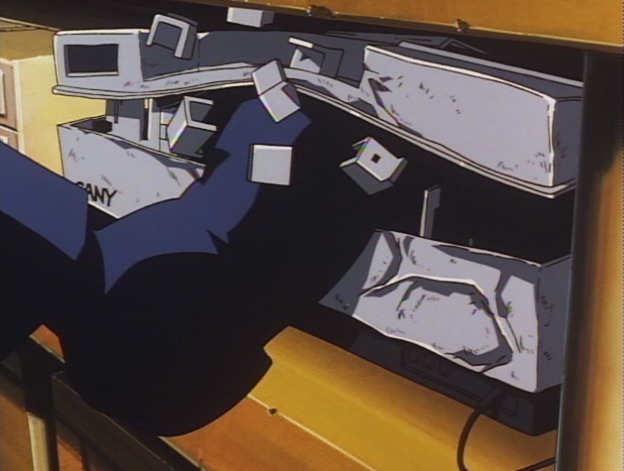
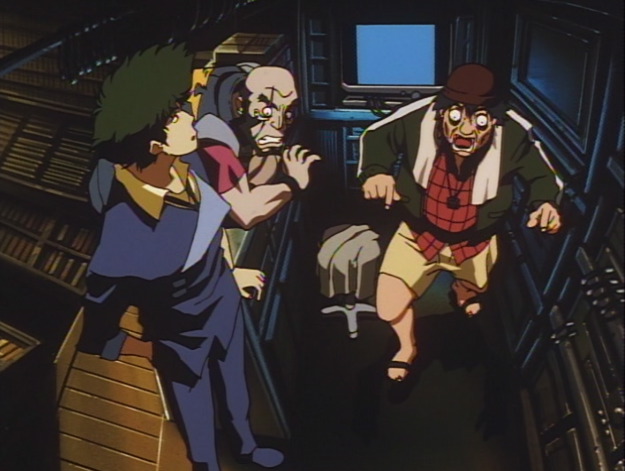
What. The. Hell.
Having successfully destroyed one of the two remaining betamax players in the world, Spike and Jet go after the other one, which lies buried in the ruins of Akihabara, Tokyo’s famous electronics/nerdly-goods district, which in the world of Cowboy Bebop has sunken into the sea.
• The BeBop travels to Japan for the first time? MEAC=6.
• The characters from Cowboy Bebop head out to the kind of place where fans of Cowboy Bebop might be expected to shop for Cowboy Bebop merchandise? MEAC=7.
• The narrative requires Spike and Jet to literally descend into an abyss?!?!
MEAC meter begins to spin wildly, and explodes in a shower of sparks. Which could itself be seen as a self-referential nod to the collector’s broken Beta deck, and… Oy. This is making my head hurt.
So yeah, it’s that literal trip to the bottom of the ocean that I was referencing in my “umplumbed depths” line. That and the fact that they do spend a bunch of time literally exploring plumbing.
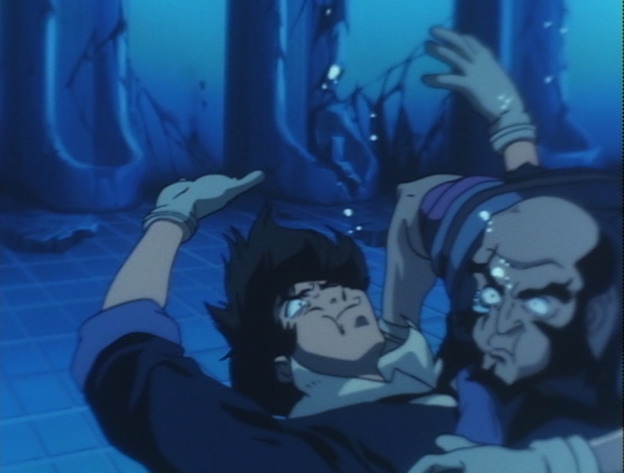
But after a bunch of these “let’s go spelunking in an abandoned building” sequences (which accomplish precisely nothing, in narrative terms), Jet and Spike find what they were looking for.
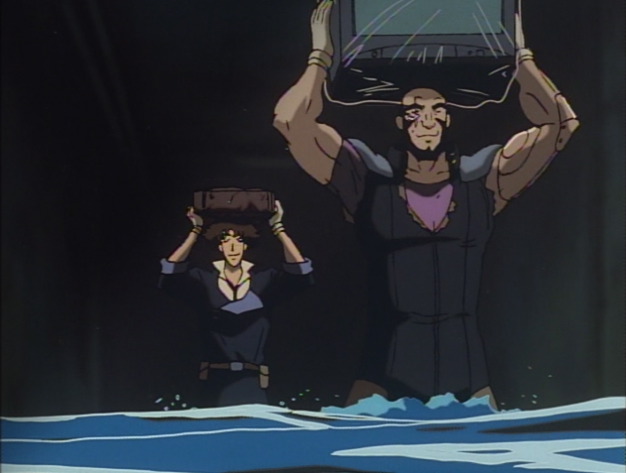
Don’t ask me how they’re planning to get these back up that bannister slide from the top of the page. They manage it somehow, because in the next scene we see them returning victorious to the BeBop, where they find…
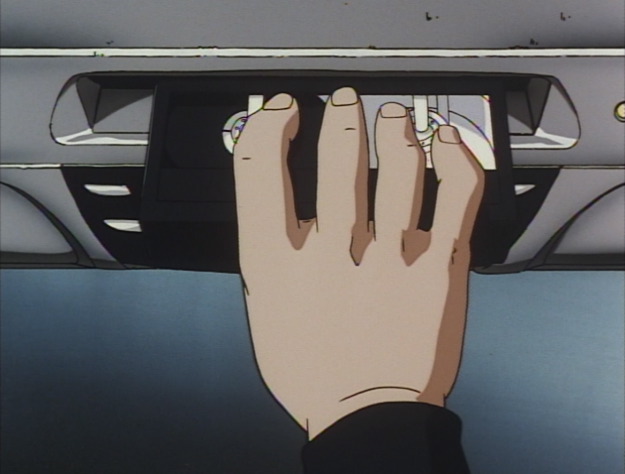
…that they accidentally picked up a VHS player instead. Bwaaaaa-ha-ha-ha-ha-ha-ha-ha!
And do note that the “much labor for no reward” structure that informs most of the actual bounty hunting is preserved in this episode as well. The shattered MEAC meter vibrates weakly, making a dull clacking sound.
But then, just as they’re about to give up hope, another package arrives, again addressed to Faye, which contains a working Beta deck. (This one was delivered by the Rabbit shipping company, which for obvious reasons got there much later than the Tortoise shipping company.) And then the episode ends with everyone watching the movie, which turns out to be a video diary that young Faye made as a message to her future self.
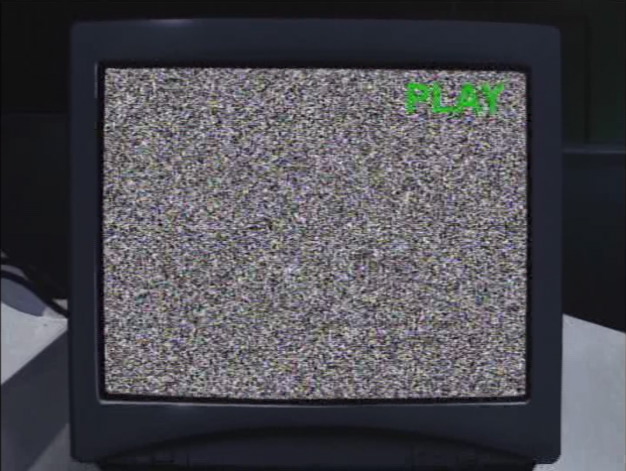
Wow. WOW. If that meter wasn't already broken, this would have killed it for sure.
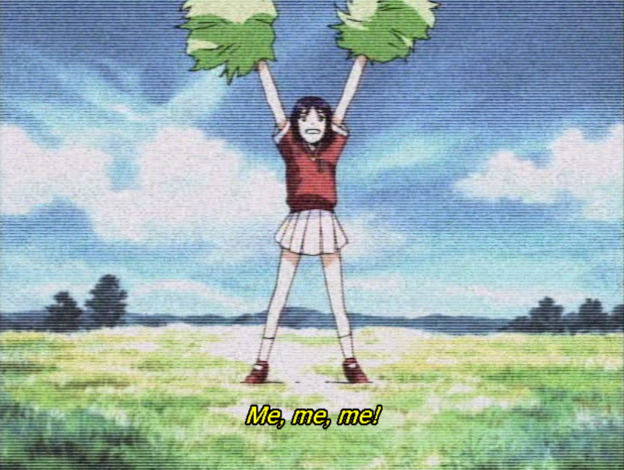
And then, finally, after all this signification, the thing itself. Smug little so 'n so, aint she?
Quite aside from the mise-en-abyme factor, there are a couple of important things to point out about that tape. One is that Faye’s handheld camera work continues the pattern of Faye-POV-shots that was established in “My Funny Valentine.” The second is that it’s SUCH a weird, spectral, uncanny moment. Faye has lost her memory, remember, and watching the tape doesn’t bring anything back (at least not yet, although there are a few episodes still to go). So she’s sitting there, watching the younger self she doesn’t remember. And at the same time, the young Faye is delivering this message to an older self that she can never possibly meet. (So again, it’s like facing mirrors – but like I said, let’s leave the mise-en-abyme out of it.) I think this speaks to something very true, and very human, about our experience of self and our experience of time.
Obviously some parts of Faye’s particular experience are contrived… Childhood memories are usually a little hazy, true, but perfect amnesiac breaks like the one that Faye has do not often occur outside of fiction. And some of the lines that young Faye delivers – things like “I’m not there anymore… but I’ll always be here, rooting for you, my only self!” – are really too perfect by half. But there’s still something recognizable about it. If I think back to myself at age 14… well, I’m not that guy anymore. He is gone. Dead and. (And note the thematic resonance with Chessmaster Hex from “Bohemian Rhapsody.”) Although we can try to trace our personal development from point A to point B, this being to an extent the basic goal of psychoanalysis, there’s always going to be a certain black-box aspect to it. The past, too, is a watery deep. It shapes us, in a sense it is with us always, but we can no more return to it than Urashima Taro can return to the Dragon King’s palace, or Faye Valentine to the Singapore that was.
I love, love, love the fact that this episode ends while they’re all still watching the video. The narrative is basically a series of internments and exhumations, right? Young Faye’s message is buried in the antique technology, then they pull it out with the right player. Faye goes away from the Bebop and buries herself in the anonymous atmosphere of the racetrack, but then she climbs back out and returns to the BeBop. Spike and Jet go down to Akihabara, and then come back up. But then at the end, everyone (the viewers, the characters, all of us) gets immersed in the show-within-the-show of Faye’s video… and the episode stops before we can come up for air. It’s a subtle effect, but a powerful one. More than any other episode so far, you walk away from this one in an altered psychological state.
Great post, as usual, Stokes. Two completely unrelated things:
1. What did you think of the cow in the mushroom episode? :)
2. I absolutely love your reading of Speak Like a Child. It just goes to show how right you are when you say that our 14-year-old selves are dead, because when I was 14 and watching Bebop for the first time, that episode made me say WTF? And I just moved on. I only figured out the second time I watched the show a couple of years ago that it’s clearly one of the best and–ahem–deepest episodes.
Several more unrelated things:
3. I find it funny that you characterize Jet as the “dad” character, because I’ve always thought of Jet as the ship’s “mom.” He’s always cooking, wearing an apron, pruning plants, having emotional outbursts — not that dads can’t do this, of course, but Jet’s outbursts to me see coded as “feminine.” The fact that he sometimes dissolves into sexism strikes me, then, as ironic.
4. If you like your Bebop meta-literary, just wait for “Brain Scratch.” It may blow (or scratch) your brain.
5. Oh, man! Next time, you’re going to see “Cowboy Funk” AND the crazy Batman-inspired episode (well, I think it’s Batman-inspired, anyway)? I cannot wait. (/ Underthinking It)
6. Ever give any thought to overthinking another anime series? Because Neon Genesis Evangelion is just sitting there, waiting around with its insane Judeo-Christian/Freudian imagery with no one to talk to. Unfortunately the music in that show isn’t nearly as good, and the tone is more serious by a factor of, like, a million… But it’s surely worth a watch.
I’ll give my full commentary on this and part 1 of Stokes’ OTI of Cowboy Bebop when I get home from work but I’d like to recommend that you ignore that request from mlawski to shy away from Neon Evagelion Genesis for two reasons: 1, it’s Judeo-Christian imagery literally makes no sense and is fully admitted by the director Anno was picked because it was foreign to its intended Japanese audience (as opposed to being fitting symbolism). And 2, NGE is a full blown deconstruction of the Super Robot Genre of anime. It’s much more poignant to have seen a handful of Super Robot series so you can compare/contrast the characters and their mecha.
I must say there something amusing, Ed was original meant to be a little black boy, but the director decided to balance male and female on the bebop and to base the character on the composer in term of persona (though I can’t say if the previous concept was similiar)
So its strange that the ed-centric episode as a lot of element blackpoitation
Another brilliant analysis! My favorite was your take on “Black Dog Serenade.” I had come up with a similar conclusion about Spike and Jet. (quote)What’s interesting is that when he’s part of the Jet+Fad team, he plays the same role that Spike plays in the Jet+Spike+Faye team: running off half-cocked, pointlessly risking his life, taking on an unspeakable badass in a close-quarters knife fight more or less just for the hell of it. The way that Fad dies in his arms at the end of the episode even has some resonance with the way that Rocco and Gren each died in Spike’s arms in their respective episodes. So if “Black Dog Serenade” explains anything about Jet’s character, it’s his weird co-dependent relationship with Spike. He never actually comes out and says “You remind me of myself, when I was your age,” but after watching this I’m not sure he even needs to.(quote)
Yeah, totally!
@mlawski, Stokes will find out on the next DVD that Jet IS the mom. :D
My Funny Valentine and Speak Like A Child also give us a viewpoint of what the future is. Faye at the beginning of My Funny Valentine is a blank slate but she has idealism for the future once she gets past freaking out and groping holograms. Things look like they might just work out: she’s going to work off the debt, she’s got a love interest and she’s adapted to the future only for Life to suckerpunch her. Her cynism begins at that moment when her George Clooney saddles her with more debt and leaves her to fend for herself. Then the video of teenage Faye wishing her future self all the best with a cheer of encouragement also showcases the idealism that Faye lost.
Jet’s misogyny ties into his whole persona as ex-cop and as the Black Dog. Men aren’t raised and don’t act like Jet. He’s the last of the Old Guard and his age as well as older world view dictate that to the viewer. This hits a bigger note in Japan as well. Women, despite having much more modern standing in society and the workplace, still face discrimination (with the whole Christmas Cake analogy that pops up in Japanese media jumping to mind).
Ed was picked to go gather food because of who she is: a kid. Someone on the planet would feel the need to help a child out. Sending Jet, Spike or Faye out to beg for food (as we all know from previous experience, they are broke) is a gamble. It also keeps Ed from repairing the ship with whomever stays behind. Seriously, would you trust Ed with a blowtorch? I’d also argue that Ed’s haul of shittake mushrooms is a pyrhic victory at best. Ed got them a lot of mushrooms but the lack of variety (especially with no guuarantee of income), you can argue that they’re merely surviving as opposed to living.
The nerdy guy who owns all the vintage electronics is more parody of the geek (otaku) who populate the shops in the Akihabara district than a writer insert (although the two aren’t mutually exclusive). Which makes it much more amusing that Spike and Jet have to go into the den of geeks to get the betamax player.
An aside, “My _____ works when I kick it” has entered my vanacular after I saw Speak Like a Child.
Another great analysis. I love reading them and look forward to the next one. FYI the Pam Grier character in Mushroom Samba is actually called “Coffee” in the closing credits. So… yeah.
I have to agree with RiderIon about Evangelion. I do like the series, and it stands on its own without having seen any other mecha series, but it’s better to watch with at least one or two of the more standard mecha series it’s deconstructing under your belt.
On a similar note, I’d love to recommend Revolutionary Girl Utena, a series that is pretty much tailor-made for a site like this. But it takes a deconstructor fleet to shoujo tropes. Another one that works on its own, but is better judged with a knowledge of where it came from.
So I’ll offer up a compromise. FLCL. It’s short, only six episodes. It’s quickly paced. And despite the surface wackiness, there’s enough meat there to dig in to. It’s also by the same studio that did Evanglion.
Of course, I want to see the rest of what you have to say about Cowboy Bebop first. I haven’t watched this series in a long time, and you’re making me think I need to watch again and pay attention.
@Wraith, you really should watch it again. :)
I’ve watched Cowboy Bebop from beginning to end at LEAST a dozen times since last June, and every time I watch it, I find something new that I missed in all the previous viewings. Either I’m not that observant or there is just so much there that it’s hard to get it all in one viewing.
I have my own opinions on Bebop, and I’m really enjoying stokes’ persepective. We don’t differ that much on a lot of things Bebop.
SLIGHTLY OFF-TOPIC, SORRY!
@Wraith: Okay, your argument about watching Revolutionary Girl Utena was so strong that I couldn’t allow myself to pass it up. That’s right: I actually watched three episodes of it last night when I couldn’t sleep. And HOLY CRAP is that show weird. Epically, epically weird. I think I may be in love. (And, yes, I have far too much experience with shoujo anime/manga, so it’s completely rocking my world. Inverted gender roles ho!)
Speaking of weird: I dunno, Stokes, FLCL may be the weirdest anime I’ve ever seen (and that’s including Evangelion, Serial Experiments Lain, Paranoia Agent, and the three episodes of Utena I watched last night). I might need to watch it again, but I definitely got the impression that it was mostly weird for weirdness’ sake, not for Overthinkers’ sakes.
You know what, Stokes? Forget what I said about Evangelion. Neither of us should watch any anime again ever. The bad stuff is AWFUL, and the most of the good stuff is 2001: A Space Odyssey-levels of bizarre. Neither really makes for good overthinking, in my view.
Although one of these days I’m going to write my post about how Miyazaki’s Spirited Away is a Marxist allegory…
@MrsSpooky: My tastes have definitely… matured, I guess you’d say, since the last time. I’m currently in the middle of a Crest/Banner of the Stars rewatch, but I think I’ll move Cowboy Bebop into the queue after it.
@mlawski: Utena is pretty high on my top-ten list, so I’m always happy to get others hooked on it. It’s harder to find in the US than I’d like it to be, though.
Paranoia Agent, yeah, that’d be another interesting selection.
As for FLCL, it’s best summed up as animated male adolescence, which gives it an interesting quality and more than one layer. Plus plenty of weirdness for weirdness sake, yes.
My all-time favorite anime is Haibane Renmei, which would be another good one for this series. I’m just more than a little obsessed with it, so I try not to go overboard with talking about it (any more than I already have). The pacing might throw off people who aren’t used to Asian cinema, but the series itself is simply wonderful. Not even far out there on the bizarre scale.
@Wraith: Actually, I already wrote about Paranoia Agent here, if you haven’t checked it out already:
http://www.overthinkingit.com/2009/03/24/overthinking-anime-kawaii-culture-superflat-and-the-bomb-in-paranoia-agent/
@mlawski The movie for Utena is completely off the deep end. It condenses the series down to about an hour and then…it gets really weird. I’d say more but…it’d ruin the surprise.
I watched an episode or two of Utena – which, due to the opening credits, I like to refer to as “Revolving Girls Utena” – a few months back, based on a description of the music as “the Vienna Boys Choir singing Megadeth in Japanese.” I’m a big fan of cinematic excess, so as you can imagine I pretty much loved it. But it would be hard for me to overthink. It seems to be one of those shows that’s always playing the signification game; where “What does THAT mean… maybe it’s about sex?” is pretty much the intended audience response. This is fine – great, even – but it means that trying to decode the symbolism is only “thinking it,” but refusing to decode the symbolism is like refusing to laugh at a comedy. Also, the like, ten minute segment of recycled footage at the climax of each episode gets pretty brutal when you’re watching episodes back to back.
I would like to see FLCL, although it is almost too odd for words.
How about some Fullmetal Alchemist? Some of the metaphors are blatant, but have great depth and since there are two different anime series the differences between them could provide much Overthinking fodder.
And why must we stay with series? Could we not also include full length movies? Specifically Akira. Unless there is an article on this already, in which case I would like a link.
I’d very much like to see this followed by Samurai Champloo actually, since the two series are very similar but extremely different. (Not to mention the obvious Watanabe link)
I met a girl at a party once who’d written more than one graduate paper on FLCL. I think that in spite (or more likely because) of its strangeness it stands as one of the better bildungsromans out there.
I wish i had discovered your breakdowns earlier! Gj! Interesting thought, i actually think the coffin was inspired by Django [1966] as well as Moby Dick.
The tape followed Faye’s cryotomb while she was frozen in it, until it finally reached her three years later when she was rewoken.